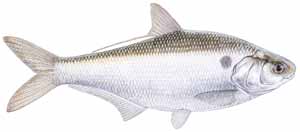Gizzard Shad (Dorosoma cepedianum)
- Other Names
- Shad, Hickory Shad, Herring, Skipjack
- Description
- Dorosoma is Greek for "lance body", referring to the lance-like shape of young shad. The species epithet cepedianum refers to the French naturalist Citoyen Lacepede. Gizzard shad are usually easily distinguished from threadfin shad by the fact that the upper jaw projects well beyond the lower jaw. Amateur ichthyologists can run a finger underneath the mouth forward, and if the fingernail catches on the upper jaw and opens the mouth, in most cases the fish is a gizzard rather than a threadfin shad. The anal fin usually has 29-35 rays, as opposed to 20-25 rays found in threadfin shad. The upper surface is silvery blue, and grades to nearly white on the sides and belly. Fins do not have the yellowing tint present in threadfin shad. Unlike threadfin shad, the chin and floor of the mouth in this species is not speckled with black pigment. Although the species commonly grows to lengths of 9-14 inches, some have been reported to exceed 20 inches in length. In Texas the record (taken with a spear gun) is an 18.25-inch specimen that weighed in at 2.97 pounds.
- Life History
- The species is most often found in large schools. The common name "skipjack" is derived from the fact that individuals within a school may often be observed leaping out of the water or skipping along the surface on their sides. Spawning generally takes place in late spring, usually in shallow protected water. Eggs and milt are released in the school, seemingly without regard for individual mates. Adhesive eggs attach to submerged objects and hatch in about 4 days. Although adult shad are moderately deep-bodied, fry are extremely slender and delicate looking until they reach about 1.25 inches in length. Gizzard shad are planktivorous. Young feed on microscopic animals and plants, as well as small insect larvae. Adults feed by filtering small food items from the water using their long, close-set gill rakes.
- Habitat
- Gizzard shad are most abundant in large rivers and reservoirs, avoiding high gradient streams.
- Distribution
- In Texas, gizzard shad are found in all major streams and reservoirs. The species is native to eastern North America. In the north the range includes the Saint Lawrence River and the Great Lakes (except Lake Superior), and extends west into North Dakota. Gizzard shad are found as far south as eastern Mexico, and as far west as New Mexico. The species is not found in New England, south Florida, or through most of the Appalachian Mountain chain.
- Other
- Gizzard shad provide forage for most game species. They rarely bite on a hook, and when they do, they are generally considered worthless as a food fish. The species is often used as cut bait for other fish species.
